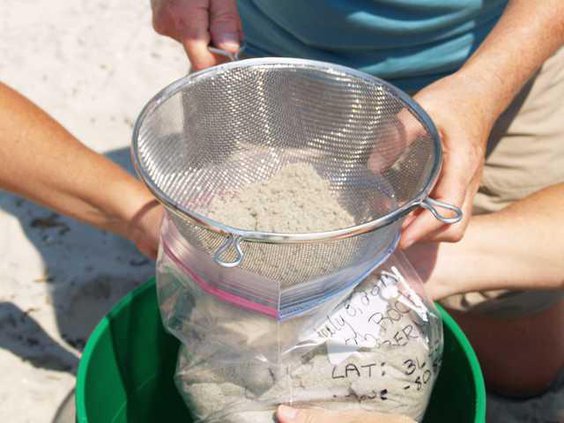Even when one can’t see plastic litter on the beach at Tybee Island, there’s a good chance there’s plastic litter on the beach. Or in it.
That’s according to research into plastics pollution by Dr. Jay Brandes, a University of Georgia Skidaway Institute of Oceanography scientist, and marine educator Dodie Sanders, who led a series of summer workshops with science teachers that revealed there are plastics present in sand on seemingly cleaned-up beaches.
The research essentially worked like this:
"We took the teachers out to Tybee Island to areas of the beach that had been cleaned up and looked nice and pristine," Brandes said. "There we took samples of beach sand and brought it back to the lab and went through procedures to extract the plastics from each sample of sand. What we found was there was a fair amount of contamination even when the sand looked perfectly clean."
A fair amount could be a half a gram of plastic contamination per kilogram of sand, he said, though those numbers seem approximate. "There’s a lot of sand out there on the beach," Brandes noted. "But it’s fairly ubiquitous."
The contamination is what Brandes calls "microplastics," essentially tiny pieces of plastic that can come from a number of sources. Their size varies, so does their shape.
"Some can be the size of a grain of sand; some can be larger or longer, like thread or hair," Brandes said. "It depends on what their sources are, and there are a lot of different ways this can get into the environment."
Sources can be anything from old fishing line, Styrofoam cups, plastic beach toys, plastic bottles and more. All are subject to breaking into smaller pieces, and smaller pieces still by the sun’s rays, the pounding of waves and weather.
But if some microplastics are unintended, others aren’t.
"There are a variety of companies deliberately making these as additives to products," Brandes said. "Some are more-well known, such as toothpaste or hand creams or facial scrubs where they’ve added little tiny beads of plastic."
Those tiny beads eventually wind up going down drains, where sewage-treatment plants aren’t able to remove them, and then can wind up being discharged into rivers or streams that drain into the ocean.
There’s so much concern some states — including New York and California — have banned the use and production of microplastics, Brandes noted.
And if it gets into the environment, it could be getting into the food chain.
"We know organisms eat this stuff, because when it breaks down into small pieces, it’s the right size for fish, for shrimp, for crabs, for birds," Brandes said. But when it gets in their stomach they’re not going to be able to digest it. So it’ll get stuck in there and they’ll eventually starve to death."
What’s more, microplastics seem to absorb certain contaminants such as PCBS or heavy metals, and if a sea creature eats one of the contaminated pieces of plastic, it ultimately could enter the food chain.
"It’s a new area of research," said Brandes, who has been at Skidaway for 10 years and studying plastics pollution on the Georgia coast for four years. "We haven’t seen a definitive study on that yet. But it is a potential problem."
What is understood is that plastics are "on every beach in the world," Brandes said, referring to a Dec. 10 report by scientists that there are more than 250,000 tons consisting of more than 5 trillion pieces of plastic in various sizes are floating around the world’s oceans.
The study notes that some scientists believe microplastics should be considered hazardous waste. Brandes said it’s a globally significant issue, and a local one.
"We knew there were microplastics out there, we know there’s a problem here, but we don’t know how bad a problem it is," he said. "How will it impact the quality of local fishing, the health of the local marshes? Those are the questions we’re asking. And there are people here trying to get a handle on it."
For Brandes and Sanders, that means continuing the study.
"Ultimately, what we would like to know is what plastics are on our beaches and how long they last," he said. "Do they last forever, or do they break down? We need to try to get an understanding of their sources — so we look and say that looks like it’s fishing line, or pieces of a cup, or little beads from a facial scrub, or so on. We’ll eventually build up a data base that tells us this is how much is coming from this source, that is how much is coming from that source. This is how much trouble they’re causing."
Once scientists have that figured out, the next step is to get that information to lawmakers so they can decide what to do next.

